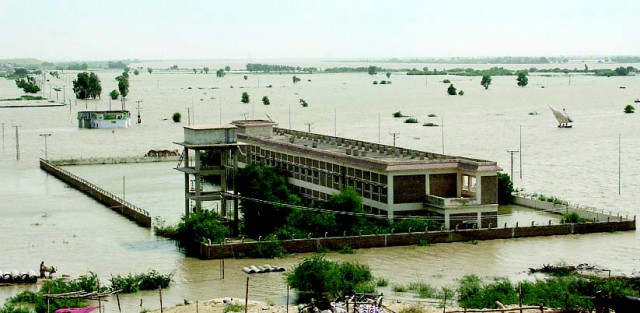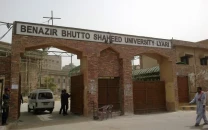Sinking silently
According to an assessment of the PDMA, the flood has directly affected about 20 districts of Sindh.

According to an assessment of the Provincial Disaster Management Authority (PDMA), the flood has directly affected about 20 districts of Sindh. As many as 2.6 million people have been affected by floods in Sindh out of which some 700,000 people were affected only in underdeveloped areas.
The floods have had multipronged effects on education as well since schools and colleges in affected areas have shut down while those in safer areas have been converted into relief camps.
Along with houses and fields, scores of schools in the kachcha areas near the Indus River have either collapsed or been damaged beyond repair.
Though the exact and official figures of the affected educational institutions are yet to come, it is feared that hundreds of schools in the flood-hit towns and villages have been damaged or destroyed in the disaster.
All educational institutes in Sindh, save those in Karachi and Hyderabad, have been affected by the floods, said Professor Iftikhar Aazmi, General Secretary Sindh Professors and Lecturers Association (SPLA). A meeting will be held between SPLA and the secretary education Sindh to discuss measures for the resettlement of affected educational institutions and students, he added.
According to the education department’s statistics, over 26,900 private and public schools had been operating in 23 districts of the province prior to the floods. Out of these, 14,805 schools were in Karachi, 1,821 in Hyderabad and 5,444 schools in other parts of the province.
The threat of floods led the government to take several precautionary measures, including closing down schools in those kachcha areas which were declared sensitive, shifting furniture and equipment in the schools to safer places and directing parents to send their children to schools in areas unaffected by the floods. The Sindh government had also asked headmasters of schools in safe areas to accept students from flood-hit localities and offer educational services to them.
However, residents in vulnerable areas moved, in many cases, to relief camps where there is little provision of food and drink. Education is definitely not the priority in these camps right now.
“Our future is so uncertain now,” said Abdullah, a student at the flood relief camp set up in Government College of Technology (GCT), SITE, Karachi. “All of us want to study,” he said, “We miss our school and teachers but right now education is impossible since our villages and schools are drowned in floodwater.”
A group of teenagers at the same camp, who came from Jacobabad district, said that water had entered school buildings. However, their furniture had already been shifted somewhere else.
Many education institutes in Kandhkot, Kashmore, Ghotki, Sukkur, Shikarpur, Khairpur, Naushero Feroz and Dadu have been handed over to the district administration for accommodating flood survivors. The EDOs education in these districts have been asked to set up control rooms in their respective district headquarters.
“It will take at least two years to restore Sindh’s educational system,” predicted Syed Khalid Ali Shah, President All Private Schools Management Association Sindh. There is also the fear that thousands of students in the province, whose families have lost everything, will be unable to continue their education even after schools are up and running.
The only bright star in the watery horizon is that most of the private secondary schools have remained safe, Shah said.
Meanwhile, sources in the office of Co-coordinator to the Chief of Reform Support Unit in Sindh said so far there is no data about the damages sustained by the education sector in Sindh. Assessment has not been started yet, they said, adding that a crises cell was formed recently to access the losses and for floating recommendations on how to restore the education system, especially for flood-affected students.
According to Secretary Education Sindh Alam Deen Billu, education of 200,000 students in 4,500 schools has been affected due to the floods in Sindh. Students in some of those schools where relief camps are set up are being taught in the evening shifts. He said flood survivors will probably be able to return to their homes in two and half months after which the teaching process in schools will resume.
Published in The Express Tribune, August 24th, 2010.



















COMMENTS
Comments are moderated and generally will be posted if they are on-topic and not abusive.
For more information, please see our Comments FAQ